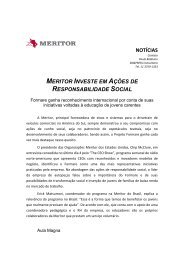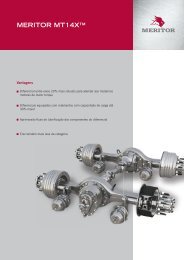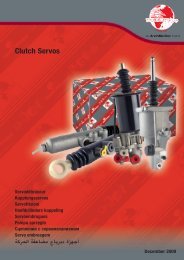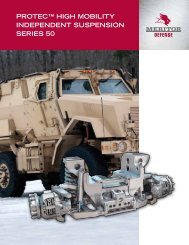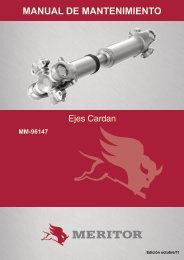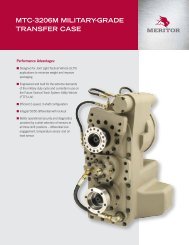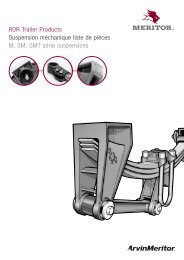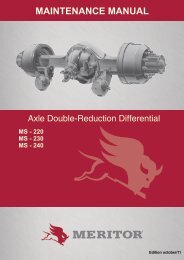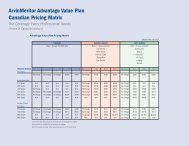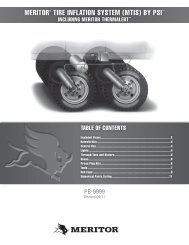MAINTENANCE MANUAL - Meritor
MAINTENANCE MANUAL - Meritor
MAINTENANCE MANUAL - Meritor
Create successful ePaper yourself
Turn your PDF publications into a flip-book with our unique Google optimized e-Paper software.
Assembly and Installation<br />
Output Flange fork or Oil Sealer Box<br />
Output Shaft Bearings.<br />
CAUTION<br />
HOLD THE SEAL ONLY ON THE OUTER<br />
DIAMETER. DO NOT TOUCH THE LIPS IN<br />
THE INNER DIAMETER OF THE SEAL. IF<br />
YOU TOUCH THE LIPS ON THE INNER DI-<br />
AMETER OF THE SEAL, YOU WILL CON-<br />
TAMINATE THE LIPS AND CAUSE A LEAk<br />
BETWEEN THE SHAFT AND THE SEAL.<br />
Do not apply pressure after the flange of the<br />
seal touches the top of the cage or you will<br />
damage the seal.<br />
1. Prepare the seal for installation.<br />
A. Apply axle lubricant to the inner bore of the<br />
output bearing cage or the outer diameter of<br />
the new oil seal.<br />
B. Place the oil seal into the cage so that the<br />
flange is parallel to the top of the cage.<br />
C. Use a press and sleeve, or a mallet and<br />
sleeve, to install the seal into the cage. The<br />
seal is correctly installed when the metal<br />
flange of the seal seats on the top of the<br />
cage. Figure 5.100.<br />
NOTE: The gap cannot be measured in the<br />
RT-40-145. The seal seats below the lip.<br />
D. After the seal is installed, a gap of 0.015-<br />
0.030-inch (0.381-0.762 mm) can exist<br />
between the flange and the cage. The gap<br />
is a normal condition because of the flexible<br />
coating on the flange of the seal. Use<br />
a feeler gauge to measure the gap around<br />
the complete flange-to-cage area.<br />
• If the gap varies more than 0.010-inch (0.254<br />
mm) between the highest and lowest measurement,<br />
remove and reseat the seal. Figure<br />
5.101.<br />
SLEEVE<br />
OIL SEAL<br />
BEARING<br />
CAGE<br />
PRESS<br />
MEASURING SEAL GAP<br />
FLAT METAL<br />
PLATE<br />
0,015 - 0,03<br />
(0,381 - 0,762)<br />
Figure 5.100<br />
Figure 5.101<br />
2. Inspect the fork surface.<br />
• If you installed a unitized pinion seal on the<br />
output bearing cage, see the section 5 and<br />
then proceed to Step 3.<br />
• For all other seals, see to the instructions<br />
below.<br />
A. Inspect the fork surface for scratches, corrosion<br />
or a wear track from the previous oil<br />
seal. Replace the fork if any of these conditions<br />
exist<br />
B. Inspect the lead chamfer of the fork for nicks<br />
and burrs which may damage the sealing lip<br />
during installation. Use an emery cloth to repair<br />
nicks and burrs.<br />
C. Wipe clean the fork sealing surface and<br />
face.<br />
D. Clean the splines in the fork or flange and<br />
on the thru-shaft.<br />
E. Apply axle lubricant to the splines in the fork<br />
or flange and the thru-shaft.<br />
• If a POSE seal is used, see the procedure<br />
in this section.<br />
78 <strong>MAINTENANCE</strong> <strong>MANUAL</strong>



